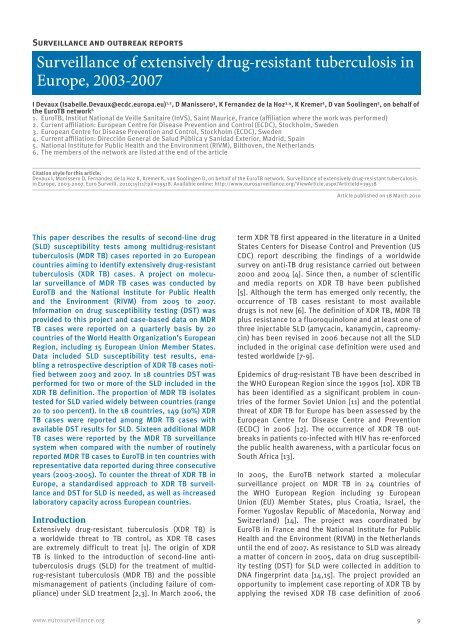Tuberculosis - Eurosurveillance
Tuberculosis - Eurosurveillance
Tuberculosis - Eurosurveillance
You also want an ePaper? Increase the reach of your titles
YUMPU automatically turns print PDFs into web optimized ePapers that Google loves.
Surveillance and outbreak reports<br />
Surveillance of extensively drug-resistant tuberculosis in<br />
Europe, 2003-2007<br />
I Devaux (Isabelle.Devaux@ecdc.europa.eu) 1,2 , D Manissero 3 , K Fernandez de la Hoz 3,4 , K Kremer 5 , D van Soolingen 5 , on behalf of<br />
the EuroTB network 6<br />
1. EuroTB, Institut National de Veille Sanitaire (InVS), Saint Maurice, France (affiliation where the work was performed)<br />
2. Current affiliation: European Centre for Disease Prevention and Control (ECDC), Stockholm, Sweden<br />
3. European Centre for Disease Prevention and Control, Stockholm (ECDC), Sweden<br />
4. Current affiliation: Dirección General de Salud Pública y Sanidad Exterior, Madrid, Spain<br />
5. National Institute for Public Health and the Environment (RIVM), Bilthoven, the Netherlands<br />
6. The members of the network are listed at the end of the article<br />
Citation style for this article:<br />
Devaux I, Manissero D, Fernandez de la Hoz K, Kremer K, van Soolingen D, on behalf of the EuroTB network. Surveillance of extensively drug-resistant tuberculosis<br />
in Europe, 2003-2007. Euro Surveill. 2010;15(11):pii=19518. Available online: http://www.eurosurveillance.org/ViewArticle.aspx?ArticleId=19518<br />
This paper describes the results of second-line drug<br />
(SLD) susceptibility tests among multidrug-resistant<br />
tuberculosis (MDR TB) cases reported in 20 European<br />
countries aiming to identify extensively drug-resistant<br />
tuberculosis (XDR TB) cases. A project on molecular<br />
surveillance of MDR TB cases was conducted by<br />
EuroTB and the National Institute for Public Health<br />
and the Environment (RIVM) from 2005 to 2007.<br />
Information on drug susceptibility testing (DST) was<br />
provided to this project and case-based data on MDR<br />
TB cases were reported on a quarterly basis by 20<br />
countries of the World Health Organization’s European<br />
Region, including 15 European Union Member States.<br />
Data included SLD susceptibility test results, enabling<br />
a retrospective description of XDR TB cases notified<br />
between 2003 and 2007. In 18 countries DST was<br />
performed for two or more of the SLD included in the<br />
XDR TB definition. The proportion of MDR TB isolates<br />
tested for SLD varied widely between countries (range<br />
20 to 100 percent). In the 18 countries, 149 (10%) XDR<br />
TB cases were reported among MDR TB cases with<br />
available DST results for SLD. Sixteen additional MDR<br />
TB cases were reported by the MDR TB surveillance<br />
system when compared with the number of routinely<br />
reported MDR TB cases to EuroTB in ten countries with<br />
representative data reported during three consecutive<br />
years (2003-2005). To counter the threat of XDR TB in<br />
Europe, a standardised approach to XDR TB surveillance<br />
and DST for SLD is needed, as well as increased<br />
laboratory capacity across European countries.<br />
Introduction<br />
Extensively drug-resistant tuberculosis (XDR TB) is<br />
a worldwide threat to TB control, as XDR TB cases<br />
are extremely difficult to treat [1]. The origin of XDR<br />
TB is linked to the introduction of second-line antituberculosis<br />
drugs (SLD) for the treatment of multidrug-resistant<br />
tuberculosis (MDR TB) and the possible<br />
mismanagement of patients (including failure of compliance)<br />
under SLD treatment [2,3]. In March 2006, the<br />
www.eurosurveillance.org<br />
Article published on 18 March 2010<br />
term XDR TB first appeared in the literature in a United<br />
States Centers for Disease Control and Prevention (US<br />
CDC) report describing the findings of a worldwide<br />
survey on anti-TB drug resistance carried out between<br />
2000 and 2004 [4]. Since then, a number of scientific<br />
and media reports on XDR TB have been published<br />
[5]. Although the term has emerged only recently, the<br />
occurrence of TB cases resistant to most available<br />
drugs is not new [6]. The definition of XDR TB, MDR TB<br />
plus resistance to a fluoroquinolone and at least one of<br />
three injectable SLD (amycacin, kanamycin, capreomycin)<br />
has been revised in 2006 because not all the SLD<br />
included in the original case definition were used and<br />
tested worldwide [7-9].<br />
Epidemics of drug-resistant TB have been described in<br />
the WHO European Region since the 1990s [10]. XDR TB<br />
has been identified as a significant problem in countries<br />
of the former Soviet Union [11] and the potential<br />
threat of XDR TB for Europe has been assessed by the<br />
European Centre for Disease Centre and Prevention<br />
(ECDC) in 2006 [12]. The occurrence of XDR TB outbreaks<br />
in patients co-infected with HIV has re-enforced<br />
the public health awareness, with a particular focus on<br />
South Africa [13].<br />
In 2005, the EuroTB network started a molecular<br />
surveillance project on MDR TB in 24 countries of<br />
the WHO European Region including 19 European<br />
Union (EU) Member States, plus Croatia, Israel, the<br />
Former Yugoslav Republic of Macedonia, Norway and<br />
Switzerland) [14]. The project was coordinated by<br />
EuroTB in France and the National Institute for Public<br />
Health and the Environment (RIVM) in the Netherlands<br />
until the end of 2007. As resistance to SLD was already<br />
a matter of concern in 2005, data on drug susceptibility<br />
testing (DST) for SLD were collected in addition to<br />
DNA fingerprint data [14,15]. The project provided an<br />
opportunity to implement case reporting of XDR TB by<br />
applying the revised XDR TB case definition of 2006<br />
9
















